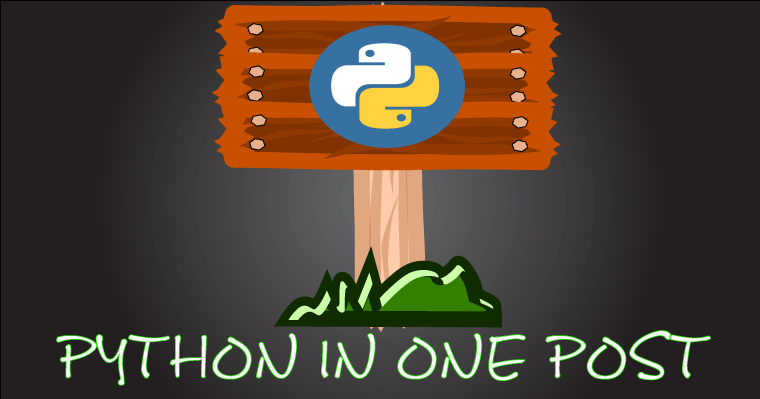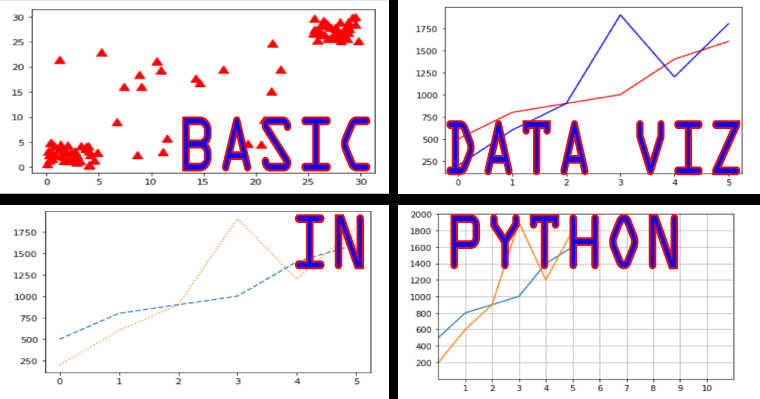195 min to read
Python in One Post
Learn Python For Free

<!DOCTYPE html>
This tutorial is for anyone that is a beginner to programming. It is designed to help you get started immeidately working on python projects. It is not intended as a complete course. Good Luck, Remember first rule in programming:
Don't Panic¶
If you would like me to make more lanuages like
R in One Post
Go in One Post
GGplot in One Post
Pandas in One Post
Anything data science related in One Post
Support my efforts and see my story at the bottom of the page.
Start by downloading Python
https://www.python.org/downloads/
Pick the latest version for your operating system.
Then download jupyter notebook
https://jupyter.readthedocs.io/en/latest/install.html
Basic math
2+2
2*2
2/2
2-2
9.0/2.0
Basic Variable types. A variable is an identifier. In basic math x = 2. X is the variable 2 is its value. It is important that we learn what each type is and how to assign it
type(2)
type(2.0)
type('2')
x = 2
print(x)
x = x + 1
print(x)
#if you want to write x = x+1 shorthand. This is common when you want to write loops in functions.
x = 2
x += 1
print(x)
x*7
x/x
x-2
x+1
Identifiers are Case Sensitive
X = 1
x = 2
print(X)
print(x)
Identifiers should have names that are meaningful
colorofmycar = 'red'
print(colorofmycar)
name = 'henry'
lastname = 'bernreuter'
print(name + lastname)
The str or string type is a string of letters. If you want to access a specific letter in a string you can. Just remebr to count the first postion as 0 not 1.
name[0]
name[4]
lastname[0]
lastname[9]
all_letters = 'abcdefghijklmnopqrstuvwxyz'
all_letters[7]+all_letters[4]+all_letters[13]+all_letters[17]+all_letters[24]
#list out all letters from the first position to the last position
all_letters[0:25]
#list out all the letters from the first positions ot the third position
all_letters[0:3]
all_letters[:]
all_letters[:25]
all_letters[0:]
all_letters[0::1]
all_letters[0::2]
all_letters[::-1]
#to find the length of string we can use a function. More about what functions are further down.
len(all_letters)
#another great str function is upper to use it name the string and .upper. You can research many more str functions
all_letters.upper()
#To split a string into other strings
new_string = 'This is my name Henry Bernreuter'
new_string.split()
#Count how many e's are in a str
new_string.count('e')
#Find something specific at a specific place in a str
new_string.find('Henry')
#Replace a word in a string with another word
new_string.replace('This','That')
You have already seen the print() function but lets add it to a str.
print("My name is", name)
#If you want to print on two sepereate lines use an escape clause
print('My name is \n',name)
#Now write a program that asks what you name is
first_name = input('What is your first name: ')
last_name = input('What is your last name: ')
print('Your full name is',first_name,last_name)
Functions. If you wanted to use the about code over and over you will use a function.These are the powerhouse of the program. First define the function with def. Then give it a name. Then add some code to it.
def whats_your_name():
first_name = input('What is your first name: ')
last_name = input('What is your last name: ')
print('Your full name is',first_name,last_name)
return
#now lets call the function. It just like the print() function.
whats_your_name()
Lists. Lists are inportant if you want to make a frame that has different variables.
list_1 = [1,2,3,'four','five','six']
#list are like strings as they are indexed the same way.
list_1[3]
list_1[:3]
list_1[3:]
#add to the list
list_1 = list_1 + [7,8,9]
list_1
#mulitple the list
list_1 *2
#How to change an element in a list. This will change 'four' to 4
list_1[3] = 4
print(list_1)
#apend the list
list_1.append('ten')
print(list_1)
#append the list at a specific index point, in this case we will inser 'one' at the index location one.
list_1.insert(1,'one')
print(list_1)
#to delete something from the list
del list_1[1]
print(list_1)
#remove something if you do not know where it is
list_1.remove('ten')
print(list_1)
Lets Make a tuple. A tuple is like a list, but once created it can not be changed. The first example we are going to make two list and combine them into a tuple using the zip() function.
num_list = [1,2,3,4,5]
letter_list = ['a','b','c','d','e']
tuple_1 = zip(num_list,letter_list)
result = list(tuple_1)
print(result)
result[1]
len(result)
result *2
Dictionaries.A dictionary is a collection which is unordered, changeable and indexed. In Python dictionaries are written with curly brackets, and they have keys and values.
d_keys = range(26)
d_values = list('abcdefghijklmnopqrstuvwxyz')
dic = dict(zip(d_keys,d_values))
dic
#locate the object at position 25
dic[25]
#Change the object at postiion 25
dic[25] = '0'
dic[25]
#Delete the object at position 20
del dic[20]
dic
#want to ask if something is in a dictionary we can use the get() function.
#it works like this nameofdicionary.get('key_value_you_are_searching_for','the_value_you_want_if_its_not_in_there')
d = {'first_name': 'henry','last_name': 'bernreuter','location' : 'Atlanta'}
d
#Its a good idea to add message indicating that the value is not there.
#In case you are searching with a loop. (more on that later)
d.get('name','its not here boss')
d.get('first_name')
#If you want to add a key to your dictionary
d.setdefault('state', 'Georgia')
d
Now we can start telling the computer what to do. IF Statement. This are the instructions for the program. IF you see this do this. IF you see a red light stop.
light = 'red'
if light == 'red': #IF you see this
print("Stop")#do this
if-elif-else statement. We are telling the computer IF you see this do this ELSE do this. This is so that you can check for different values.
light = 'green'
if light == 'red': #IF you see this
print('stop')#do this
elif light == 'green':#Else IF you see this
print('go')#do this
else:#IF you see nothing else
print("These lights are not working")#do this
light = 'red'
if light == 'red': #IF you see this
print('stop')#do this
elif light == 'green':#Else IF you see this
print('go')#do this
else:#IF you see nothing else
print("These lights are not working")#do this
light = 'yellow'
if light == 'red': #IF you see this
print('stop')#do this
elif light == 'green':#Else IF you see this
print('go')#do this
else:#IF you see nothing else
print("These lights are not working")#do this
FOR loop. Loops are the powerhouse of all programming lanuages. If you need to do something twice you need to loop it.
num_list = range(10)
for all_the_numbers in num_list:
print(all_the_numbers)
#Here we can combine everything we have learned to make a Christmas tree.
count_spaces = 34
start_count = 0
while count_spaces > 0 and start_count < 33 :
print('\33[1;32;48m'+' '*count_spaces+'*'+'*'*start_count+'\33[0m')
count_spaces -= 1
start_count += 2
for christmas_tree in range(3):
print(' '*33,'||')
print(' '*32, end = '\====/')
print('')




